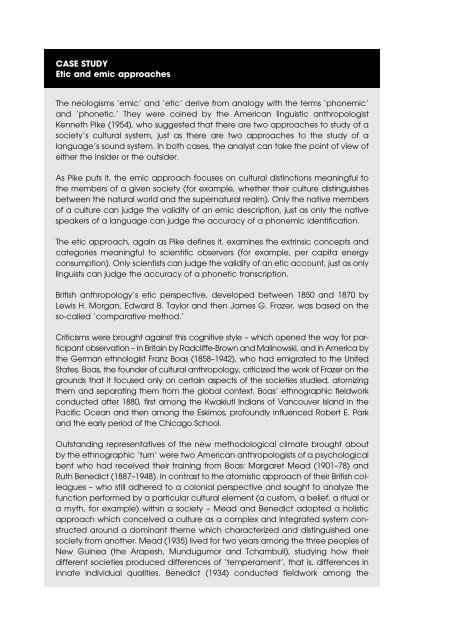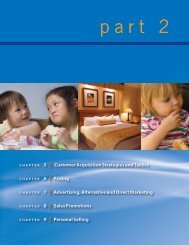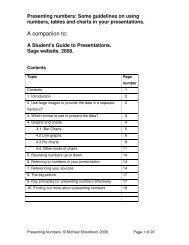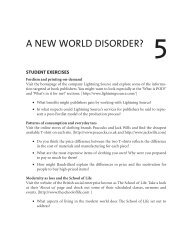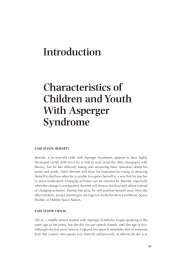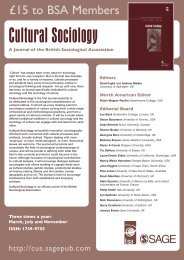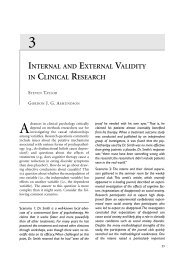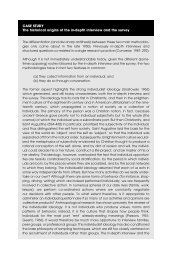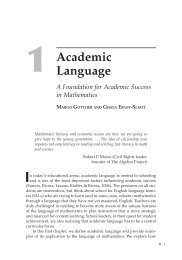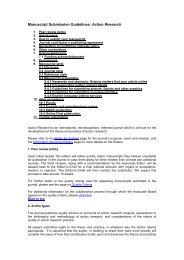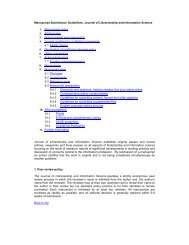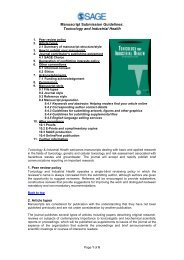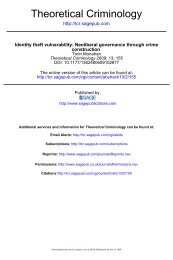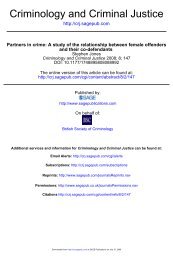CASE STUDY Etic and emic approaches - Sage
CASE STUDY Etic and emic approaches - Sage
CASE STUDY Etic and emic approaches - Sage
Create successful ePaper yourself
Turn your PDF publications into a flip-book with our unique Google optimized e-Paper software.
<strong>CASE</strong> <strong>STUDY</strong><br />
<strong>Etic</strong> <strong>and</strong> <strong>emic</strong> <strong>approaches</strong><br />
The neologisms ‘<strong>emic</strong>’ <strong>and</strong> ‘etic’ derive from analogy with the terms ‘phon<strong>emic</strong>’<br />
<strong>and</strong> ‘phonetic.’ They were coined by the American linguistic anthropologist<br />
Kenneth Pike (1954), who suggested that there are two <strong>approaches</strong> to study of a<br />
society’s cultural system, just as there are two <strong>approaches</strong> to the study of a<br />
language’s sound system. In both cases, the analyst can take the point of view of<br />
either the insider or the outsider.<br />
As Pike puts it, the <strong>emic</strong> approach focuses on cultural distinctions meaningful to<br />
the members of a given society (for example, whether their culture distinguishes<br />
between the natural world <strong>and</strong> the supernatural realm). Only the native members<br />
of a culture can judge the validity of an <strong>emic</strong> description, just as only the native<br />
speakers of a language can judge the accuracy of a phon<strong>emic</strong> identification.<br />
The etic approach, again as Pike defines it, examines the extrinsic concepts <strong>and</strong><br />
categories meaningful to scientific observers (for example, per capita energy<br />
consumption). Only scientists can judge the validity of an etic account, just as only<br />
linguists can judge the accuracy of a phonetic transcription.<br />
British anthropology’s etic perspective, developed between 1850 <strong>and</strong> 1870 by<br />
Lewis H. Morgan, Edward B. Taylor <strong>and</strong> then James G. Frazer, was based on the<br />
so-called ‘comparative method.’<br />
Criticisms were brought against this cognitive style – which opened the way for participant<br />
observation – in Britain by Radcliffe-Brown <strong>and</strong> Malinowski, <strong>and</strong> in America by<br />
the German ethnologist Franz Boas (1858–1942), who had emigrated to the United<br />
States. Boas, the founder of cultural anthropology, criticized the work of Frazer on the<br />
grounds that it focused only on certain aspects of the societies studied, atomizing<br />
them <strong>and</strong> separating them from the global context. Boas’ ethnographic fieldwork<br />
conducted after 1880, first among the Kwakiutl Indians of Vancouver Isl<strong>and</strong> in the<br />
Pacific Ocean <strong>and</strong> then among the Eskimos, profoundly influenced Robert E. Park<br />
<strong>and</strong> the early period of the Chicago School.<br />
Outst<strong>and</strong>ing representatives of the new methodological climate brought about<br />
by the ethnographic ‘turn’ were two American anthropologists of a psychological<br />
bent who had received their training from Boas: Margaret Mead (1901–78) <strong>and</strong><br />
Ruth Benedict (1887–1948). In contrast to the atomistic approach of their British colleagues<br />
– who still adhered to a colonial perspective <strong>and</strong> sought to analyze the<br />
function performed by a particular cultural element (a custom, a belief, a ritual or<br />
a myth, for example) within a society – Mead <strong>and</strong> Benedict adopted a holistic<br />
approach which conceived a culture as a complex <strong>and</strong> integrated system constructed<br />
around a dominant theme which characterized <strong>and</strong> distinguished one<br />
society from another. Mead (1935) lived for two years among the three peoples of<br />
New Guinea (the Arapesh, Mundugumor <strong>and</strong> Tchambuli), studying how their<br />
different societies produced differences of ‘temperament’, that is, differences in<br />
innate individual qualities. Benedict (1934) conducted fieldwork among the
Pueblos Indians of New Mexico, the Dobu living on the isl<strong>and</strong> of the same name<br />
off the south-western tip of New Guinea, <strong>and</strong> the Kwakiutl Indians, as her teacher<br />
Boas had done. Today most cultural anthropologists agree that anthropological<br />
research should gather both <strong>emic</strong> <strong>and</strong> etic knowledge. Emic knowledge is essential<br />
for the intuitive <strong>and</strong> empathic underst<strong>and</strong>ing of a culture, <strong>and</strong> also for<br />
conducting effective ethnographic fieldwork. Moreover, <strong>emic</strong> knowledge is<br />
often a valuable source of etic hypotheses. <strong>Etic</strong> knowledge, on the other h<strong>and</strong>, is<br />
essential for cross-cultural comparison. It is indispensable for ethnology, because<br />
comparison necessarily requires st<strong>and</strong>ard units <strong>and</strong> categories.


